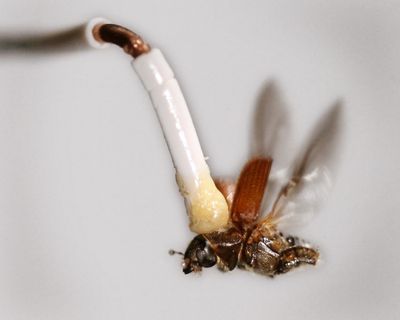$40 million pledged to battle bark beetle
Minnick hopes to get additional Forest Service funds for Idaho

DENVER – The U.S. Forest Service will funnel an additional $40 million to Rocky Mountain states where a tiny bug has killed more than 2 million acres of pine trees in what has been called one of the West’s biggest natural disasters.
Agriculture Secretary Tom Vilsack, whose agency oversees the Forest Service, said Tuesday the funds will help address the growing threats from stands of trees devastated by bark beetles.
Forest officials say threats include the risk of catastrophic wildfire, injury and property damage from falling trees and damage to waterways from erosion.
The money is targeted for Colorado, Wyoming and South Dakota, where some of the worst outbreaks have occurred. However, additional money could become available for Idaho, said John Foster, a press secretary for U.S. Rep. Walt Minnick, D-Idaho.
“Walt and Secretary Vilsack spoke today,” Foster said. “We hope to have an announcement in the coming days regarding funding for Idaho.”
The beetles have chewed their way through nearly 1.3 million acres of trees in the state, leaving swaths of red-needled pine trees in central Idaho’s Sawtooth National Recreation Area and Lookout Pass in northern Idaho.
Colorado Gov. Bill Ritter, who joined Vilsack for the announcement, said communities in the beetle-plagued forests also face economic losses from drops in tourism.
The tiny beetles burrow under the bark of pine trees and have killed more than 2.5 million acres of trees in Colorado and southeastern Wyoming. The bugs the size of a match head lay their eggs inside the tree, turning the green needles to the color of rust as they feed on the tree and restrict its ability to draw water.
Colorado and Wyoming campgrounds have been temporarily closed because of falling trees. Contractors have cut trees around communities and recreation areas.
The Forest Service says more work is needed to protect the hundreds of miles of power lines and thousands of miles of roads and trails in the forests.
A national management team is helping regional forest officials deal with the effects. Sen. Mark Udall, D-Colo., is sponsoring a bill allowing the Forest Service to identify high-priority areas and expedite analysis of proposed treatments.
Udall has called the beetle outbreak “one of the biggest natural disasters we face in the West.”
The $40 million infusion for the response means the Forest Service office based in Denver won’t have to shift money from areas not affected by the bark beetle, agency spokesman Steve Segin said.
The Forest Service’s Rocky Mountain region had said about $50 million was needed to battle the bark beetle. Some national forests in Wyoming were bracing for cuts they feared could close campgrounds.
While bark beetle infestations are considered part of natural cycles, experts say drought and warmer temperatures are worsening the current outbreak. The region hasn’t had prolonged freezing temperatures that would help kill the bugs, and drought has weakened the trees.
Other Western states with beetle infestations are Montana, New Mexico, Oregon and Washington.
Not everyone is convinced that the swaths of dead trees are a wildfire threat. Research shows that climate – hot, dry weather – is the driver behind forest fires, said Tom Veblen, a University of Colorado geography professor who studies forest ecology. He has said the lodgepole pines, the trees attacked by the mountain pine beetle, are fire-prone anyway.
And Suzanne Jones, director of the regional Wilderness Society office, said it will be important to spend the money wisely.
“Having funding to get boots on the ground has always been the limiting factor,” said Jones, a member of the Colorado governor’s forest health council.
But Jones said the money needs to go to high-priority areas, including communities on the edges of affected forests.
“It doesn’t mean we now need to go and cut down every dead tree in the backcountry,” she said.